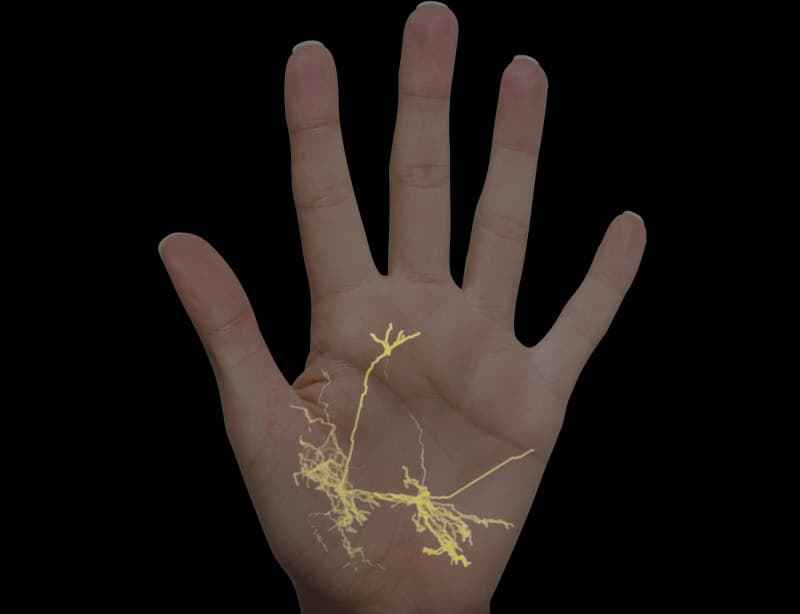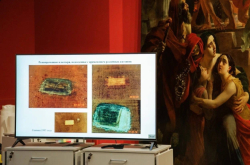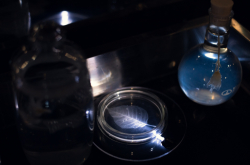What’s Optomycelium
The project Optomycelium 2022 is implemented by ITMO’s Art & Science Center under the aegis of the M-platform Arts and Sciences. Optomycelium started as an exhibition (open at Art.ITMO.Residency until February 13) and became a permanent platform for communication between artists and scientists.
The project aims to popularize ITMO University’s research activities and increase society’s level of trust in technologies.
Participation in the project will allow scientists to:
-
share their research with the public;
-
increase the level of public trust and interest in technologies;
-
take a fresh look at their research projects;
-
improve creative thinking skills;
-
unlock their artistic potential while working on an art & science project;
-
receive financial support;
-
publish academic papers in prestigious interdisciplinary journals, such as Nature Communications, Scientific Reports, Leonardo, etc.
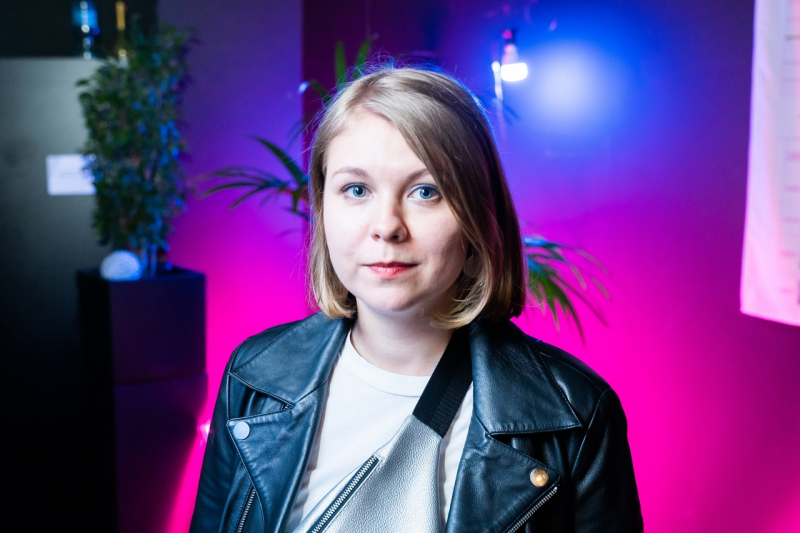
Khristina Ots. Credit: ITMO.NEWS
Khristina Ots, head of Optomycelium
“This year we decided to conduct an experiment and reverse the usual model for creating art & science projects. Instead of bringing an artist with a finalized project idea to the laboratory, we decided to hold an open call for researchers in order to find out what scientific projects they would like to share with the public and which inventions they would like to reimagine through artistic means. We’re looking forward to applications from scientists and will share their proposals with artists so that they could come up with art projects beneficial for both parties.
This project is quite unique and important, as it provides opportunities for long-term collaboration and financial support. ITMO isn’t a leader in only scientific and research activities; it’s also a multidisciplinary university with the potential for becoming a key institution that creates and maintains interdisciplinary art & science projects in Russia.
Breakthrough ideas don’t come as if from nowhere. They appear when there's efficient communication between specialists from different fields. The main task of the Art & Sciences M-platform is to create a community of like-minded people and support their collaboration.”
How to join
The Optomycelium 2022 open call is welcoming all scientists, lecturers, and students from ITMO University. The participants should propose which of their research projects or inventions they would like to reimagine together with artists and share with the public. The coordinators and artists will select the ones that will be used as a foundation for art & science projects.
In order to apply, fill out this form (in Russian).
The application deadline is February 13, 2022.
For further inquiries, write to air@itmo.ru with “Optomycelium 2022” in the subject line.
Outline of the project
-
The results of the open call will be announced in late February 2022.
-
Interdisciplinary teams consisting of researchers and artists will be formed. They will work on their art & science projects during the year.
-
Optionally, the researchers will be able to take part in the public educational program of the Optomycelium 2022, which includes lectures, discussions, and workshops.
-
The results of their art & science collaboration will be presented at the exhibition at Art.ITMO.Residency in December 2022.
What support the participants will receive:
-
mentorship;
-
courses in art & science;
-
financial support (student project funding and payment to research consultants who will help the artists).
Project examples and insights
Alexandr Kapitonov
dean at the Faculty of Infocommunication Technologies
We have been cooperating with the Art & Science Center for a long time. To me, two projects especially stand out. From the point of view of the impact on the viewer, it’s without a doubt Physarum-Fortuneteller. The element of surprise is at work here: while the viewer is following the complex patterns that slime mold physarum draws on the scan of their palms, the computer runs a social media search for information on the viewer and then uses it to share personal facts about them supplemented by its comments. This was shocking to many.
From a scientific point of view, I was really into the Pangardenia project that helped the natural world and robots meet through art. We used a drone boat to gather information on the quality of water at different spots of St. Petersburg channels and used this data to create music for the project. Thanks to Pangardenia, we took a fresh look at the ways engineering projects can be presented to the public.
Now we opened a coffeehouse, where a robot makes waffles; then Gaka-Chu, the robot-artist, joined the project and started selling its NFT artwork. Artists help us promote complex concepts through projects like this and become engaged with the new technologies themselves.
Arina Buzdalova
a researcher at the International Laboratory “Computer Technologies”
Together with young artists, Maxim Buzdalov and I created the Hybris project, an interactive computer model of the evolution of bacteria. We visualized clusters of digital bacteria that evolved according to evolutionary algorithms. Users could introduce new bacteria, remove or add nutrients, and observe how these actions affect the course of evolution.
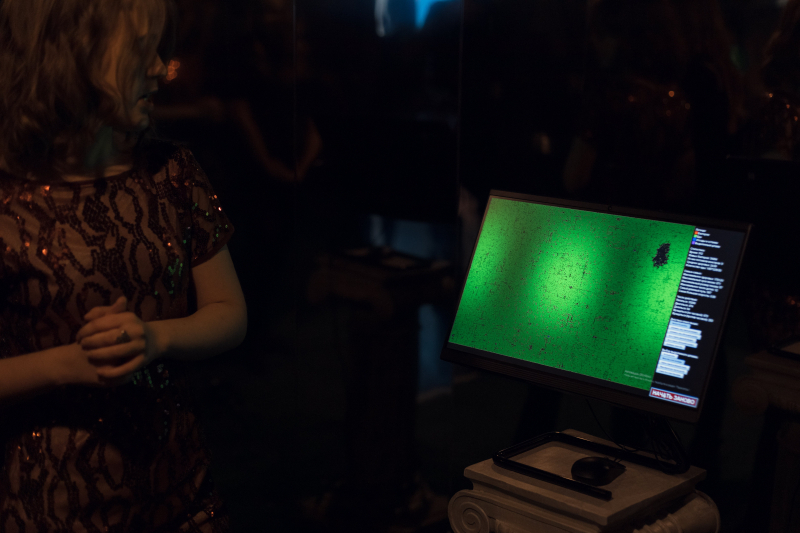
Hybris. Credit: ITMO.NEWS
This project allowed us to take a new look at our field of studies and realize that it can be popular. Maxim completed the model a long time ago simply out of curiosity but as we acquired more experience and inspiration, we rediscovered it for our project and realized that it can become a way to study the way complex behavior develops in a system that simulates natural conditions.
Working with artists is a great way to connect to the world around you. The project was exhibited at ITMO’s Art.ITMO.Residency and at the Izich club. I was very inspired by the reaction of the club's visitors: people willingly interacted with the installation, asked about evolutionary algorithms, and thanked us for popularizing things that were previously known only to specialists.
Svetlana Ulasevich
an associate professor, the head of the biomimetic materials team at ITMO University’s Infochemistry Scientific Center
Together with the artist Galina Alferova, we worked on the project Mom, Look, Dolphins!, presented at the exhibition Optomycelium 2021. For this project, we created sea scents that served as a visual demonstration of what could happen to our planet in the future. Our installation was supposed to represent a nostalgic story from the year 2070 – by that time, the sea would have changed irreversibly. We wanted people to think about the fact that the sea can become so dirty that no one would even consider relaxing on the beach and remind them that the future is in our hands.

Mom, Look, Dolphins! Credit: Dmitry Grigoryev, ITMO.NEWS
Scents are a hobby of mine, I collect perfumes and love to create them, so it was interesting for me to work on this project. When creating the scent of the sea, we had to decide which way to go: to reproduce the way the sea actually smells or create a complex perfume that would remind you of the sea through direct associations. We chose the second option.
Working with Galina was pure joy. I love collaborating on creative projects that are related to my personal hobbies. Switching from one activity to another helps me regain my energy and when I go back to my primary scientific work, it goes much smoother. Galina and I already have a couple of ideas for future projects to create together.
Semyon Koltsov
a PhD student and a researcher at SCAMT
Artist Galina Alferova and I came up with an impressive visualization for chaos and the butterfly effect. We presented it at the Cyfest-12 festival and, shortly put, it was cool and beautiful.
As they say, resting is the change of activities, so working on the project was like a vacation to me, even though sometimes I had to think hard to solve engineering problems.

High Sensitivity. Credit: Dmitry Grigoryev, ITMO.NEWS
Switching to a different viewpoint makes you think outside the box, which is useful. Besides, science and art, in my opinion, are not so far apart. Both are based on abstraction and the ability to determine and convey the very essence of something. So, at some level, we can say that these two phenomena are basically the same. It’s the implementation that makes them different.
I have ideas for future art & science projects. I think that educating people is great and I love this format of popular science.


